2009 Yamaha Yzf6r
This is my guide to buying a used Yamaha R6 (formally known as the Yamaha YZF-R6) — what to look for, what can go wrong, and the best models to buy.
The Yamaha R6 is known as the most uncompromising track-oriented motorcycle on today's roads.
But buying a used Yamaha R6 is hard. They've been around for twenty years! What's the best year R6 to buy? How do you know if it has been thrashed… or crashed? What problems does the R6 have? And how can you check?
All this and more in my latest buyers guide to the Yamaha R6, one of the most incredible motorcycles you can put on the road today.
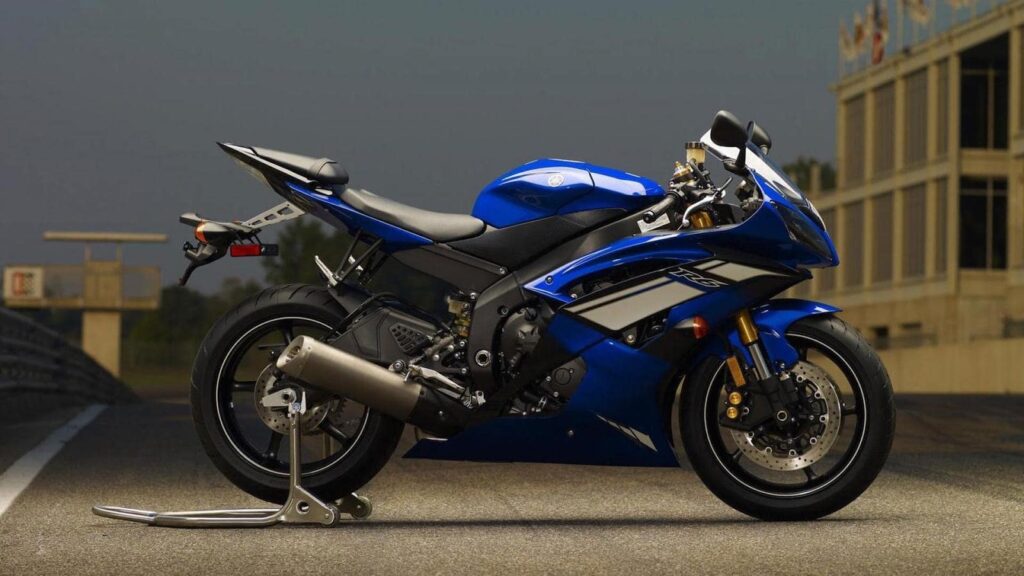
As one of my favourite reviews (ever) put it:
Basically, if the YZF-R6 could be bottled and sold on street corners we'd end up junkies… trading in our homes for shopping carts, hanging around recycling centers, rummaging through trash bins for cans and bottles, anything to scrounge up enough cash for one more glorious hit at 15,500 revolutions per minute. Rehab be damned." – Motorcycle.com on the 1999 Yamaha YZF-R6
Don't worry. The rev limit has since increased from 15,500 to 16,000!
Are you obsessed with motorcycles?
Well, I am. That's why I created this site — as an outlet. I love learning and sharing what others might find useful. If you like what you read here, and you're a fraction as obsessed as I am, you might like to know when I've published more. (Check the latest for an idea of what you'll see.)
Why trust me on motorcycles?
Because I admit I don't know everything, I try to give a balanced viewpoint, with objective information, helping as many people as possible.
Buying motorcycles is hugely independent. You might love something, and I'll like it less it. Everyone has unpopular opinions. That's why I try to keep to facts. And where there's a subjective opinion, like how fast something feels or how it handles, I'll try to present a balanced opinion that lots of reviewers share.
But the goal here is to haveall this information in one spot. You read this, and you know everything you need to know about the Yamaha R6 to go to someone selling a used one and be an encyclopaedia. "Oh it's the 2006? Yeah I know they say they go up to 17,500 rpm but it turned out Yamaha was lying." Bam! There's $500 off (or something).
I write these buyer's guides based on a mixture of my own experience in riding these motorcycles, reading everything on the internet, and trying to distil it all into a guide that will help you go make the right purchase.
Why buy a Yamaha R6?
In a nutshell, you buy a Yamaha YZF-R6 if you want an uncompromising, race-winning, raw motorcycle that you can more easily (but still not easily) push to its limits than a litre-bike.
You buy an R6 if you value power, speed, and thrills all more than your wrists, license, or perhaps your life. (Stay safe. And wear your gear!)
You might also buy an R6 because you want to ride a 600cc sportbike once in your life before the class is extinguished — something which is slowly happening.
From my favourite review of the Yamaha R6:
"Never mind the bollocks, we'll get right to the point: The Yamaha R6 kicks ass. It's one of the most feral, thrilling, heart-pounding motorcycles we've ever ridden." – Motorcycle.com, 1998
There are lots of reasons why a Yamaha R6 might be the motorcycle for you. As it is for me! (One of them, anyway.)
It was the 1998 Yamaha YZF-R1 that stole the show in the late nineties, stealing the crown from the Honda FireBlade, that had set new standards for production motorcycles. Honda was at the time known for producing motorcycles that were fast, but able to be controlled. In fact, that was the ethos of the designer, Tadao Baba: "Total Control".
Yamaha's R1, or its companion the R6, were NOT sedated machines. They were raw, visceral, extremely powerful, and dangerous in the wrong hands. But man, are they fun to ride.
The reason why the Yamaha motorcycles were so different to the Hondas came from the design ethos. In contrast to the ethos of the FireBlade of "Total Control", guiding principle behind both the R1 and the R6 was "excitement".
Kunihiko Miwa, the project leader for the Yamaha YZF-R6 (and Yamaha YZF-R1), who is now a senior executive at Yamaha, wanted to build motorcycles "with no compromise". This was why the R1 and R6 weren't based at all on a shared platform, or with any shared parts, for example.
"If you want to build a perfect super-sport machine, you can not make faulty compromises." Kunihiko Miwa, project leader for the Yamaha R6 and R1
There are more reasons than the word "excitement" to buy a Yamaha R6, though.
Firstly, the Yamaha R6 is powerful. The Yamaha R6 was the first 600cc production super-sport that made over 100hp (75kW) in stock form. This is a huge amount of power for any motorcycle, but particularly so for one as light as the R6 — it weighed less than 170kg fully fuelled. Wow!
This continued for the life span of the YZF-R6. The Yamaha R6 has not been notthemost powerful 600cc-class motorcycle in every model year, but it has always been powerful enough to do serious damage.
Secondly, the Yamaha R6 is an excellent track motorcycle. You could argue that any other 600cc-class motorcycle is, but according to the opinions of many forum dwellers, none come as close to "track-ready" as the R6 in stock form.
Personally I think this is more up to the rider, and I also think most buyers tend to ride street a lot more than track (depends on where you live in the world), so I'd still say this shouldn't be your primary consideration.
In numbers, Yamaha hasn't won as many manufacturer's titles in the World Superbike Championships as has Honda with its CBR600RR, but it is still in second place! Remember, they get to choose their riders, and they're mostly smaller than you and I are.
What's the Yamaha R6 like to ride?
Firstly, the Yamaha R6 has always been primarily a track bike that justhappens to be street legal.
What an R6 is like on thestreet is most people's question. After all, we all know it does well on the track.
To be fair, I'm not really a frequent track rider. I've done a few track days, but I ride mostly on public roads. I ride motorcycles to the shops, out in the countryside, in the African bush, in the Middle Eastern desert (well, on the roads there), down through America's snaking highways, and hopefully in the future on the Autobahn (some day).
But to describe what it's like to ride the R6 — or indeed any 600-class sportsbike (the ZX-6R 636 is very similar in experience, as is the Honda CBR600RR) — you have to understand the torque curve.
Firstly, you'd never describe the Yamaha R6 as "torquey".
Like most four-cylinder 600cc motorcycles, Yamaha R6 makes most of its power high up. But that's not the full story.
Let's look at the torque curve of the Yamaha R6.
Quick note on torque: I like to think of what it's like to ride a motorcycle by analysing torque curves, because these translate to real world riding experience. Coupled with gearing, final drive ratio, and the wheel diameter,the torque is the best indicator of what a wide-open throttle feels like at any given rpm number. Torque is pull, whereas power is energy delivered. You need that energy to get through wind resistance and make top speeds. Also, power = torque * rpms, so a little torque high up gives the same power as a lot of torque down low; that's why massive V-twins may have huge torque, but little overall power, and it's why a 600cc motorcycle makes relatively little torque down low, but large high-end power.
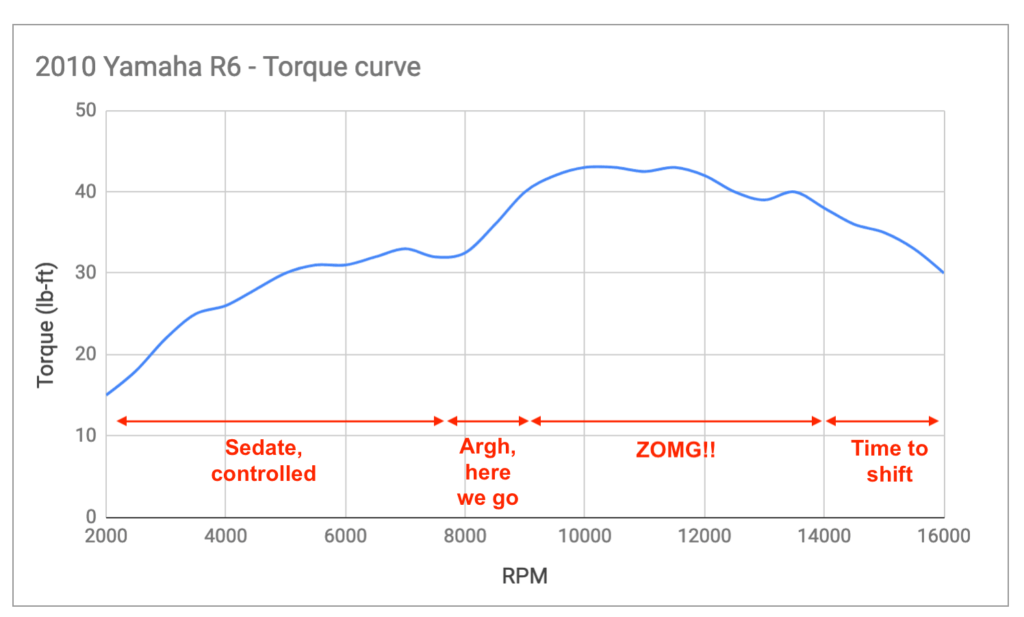
Most Yamaha R6 models peak at somewhere around 55-60 Nm of torque (40-45 lb-ft) of torque. And yes, torque peaks somewhere around the 10,000 rpm point, and stays up there for a while.
- At around 3,000 rpm, the R6 is making about half its peak torque — roughly 30 Nm (or 20 lb-ft) of torque. This is what a Yamaha R3 makesat its peak. Nobody really talks about small 300cc motorcycles as being "peaky". At 3,000 rpm, a more street-tuned motorcycle like the Suzuki SV650 is making about 50 Nm (36 lb-ft) already.
- At 6,000 rpm, a Yamaha R6 makes around 45 Nm (~30 lb-ft) of torque. But by this point, a street-tuned motorcycle like an SV650 is making 50 lb-ft. They're still pulling harder.
- Where it gets different isabove 8-10,000 rpm. At this point, the Yamaha R6 reaches 90% of its peak torque. But a street-tuned motorcycle's torque startsdropping above 8,000 rpm. Because power = torque * rpm (* a multiplier), this is where the power is made.
- The Yamaha R6 keeps pulling with about 95% of peak torque until close to its redline, about 14,000 rpm, where its torque starts dropping until the rev limit of 15,500-16,000 rpm.
This means that to ride a Yamaha R6,you have to keep it revving between 8-14,000 rpm to really feel it pull. To ride a Suzuki SV650, you keep it between 3-8,000 rpm. It's a really different feeling and sound.
So back to "torquey": the R6 isn't it. Below about 6,000 rpm it feels boring, sedated, kind of like an airplane taxiing on a runway. It's not designed to go this slow, but it'll do it, just to get to where it's in its element.
But at about 8,000 rpm the R6 starts to bellow, and by 10,000 rpm it is singing. From that point, there's a massive strata of ripping high power that's a joy to crank up around a deserted road. You feel glad you're leaning forward onto those bars, because otherwise your arms would be ripped off. You have to keep the gearbox going to make sure it stays in this range, but if you do, you'll be laughing into your helmet's visor!
As you hold on to the throttle, the revs climb to a way higher pitch than you think sounds reasonable. It just keeps going up, and up, and up, and power never really drops off (even though torque does). It's often only when people hit a limiter that they realise they should shift; it takes discipline to shift earlier, because the rush is so good.
On to a few specific situations.
Riding the Yamaha R6 on the street or traffic
Youcan ride the Yamaha R6 on the street, and it's not wholly unpleasant, but it can get annoying if you do it for more than 30 minutes to an hour every day.
The plus side is that the R6 is lightweight and narrow, which means splitting lanes isn't hard (assuming it's legal where you are, like California, Australia, or the rest of the world… but not in most states in the US).
It gets a bit frustrating keeping the motor revving just to move between cars. Again, it's fine if you're on your way to somewhere interesting to ride.
The narrow, forward position of the clip-ons (which varies by model year) means that your weight is always over the front wheel, which isn't an optimal way to steer at low speeds. Plus, it can hurt you if you don't have a strong core or flexible wrists.
Basically, if my commute had any more than ten minutes of low-speed traffic, I'd be eyeing something like an upright standard.
Finally, if you're riding just in traffic/in the city, you'llnever have the motor in the peak of its powerband, above 10,000 rpm (where it'd be doing at least 60 km/h or 40 mph). This means you'll always be riding a motorcycle with far less torque than other, similarly-sized, and cheaper motorcycles. So if commuting is your thing… I wouldn't opt for an R6. Instead, I'd look at something like a CBR650R.
Here's what Cycle World had to say about the 2008 Yamaha R6:
Around town, though, the low-end and mid-range performance still disappoints. The bike is astonishingly fast if you keep the engine singing at five-digit rpm levels, and its handling on a twisty back road is nothing short of spectacular. But the acceleration anywhere in the bottom half of the rpm range is extremely weak, so much so that roll-on acceleration is practically imperceptible, and attempts to leave a stop light with vigor cause the engine to bog. — Cycle World
Blergh.
Riding the Yamaha YZF-R6 on the freeway
This is more pleasant than stop-start traffic, but it's boring.
And you better bring the best earplugs you can get, because that singing high-revving motor can really scream! At 70mph, you're at about 5-6,000 rpm, which isn't massive, but when you drop a gear to pass, it howls. (This depends slightly on the generation — earlier ones were geared for lower engine speed).
The Yamaha YZF-R6 is also not near the peak of the torque curve when cruising in top gear. If you compare riding an R6 on the freeway to almost any other medium-sized motorcycle, it can be frustrating, because many of those (like litre-bikes, for example) can pull away with ease without shifting. To pass quickly on an R6, you should shift down.
The question becomes:do you ride a motorcycle because you like shifting? It's a weird one; for some it's yes, for some no!
Anyway, a few other things make the Yamaha R6 not great for the freeway:
- The riding position gets uncomfortable
- Wind protection is only enough if you're in tuck (uncomfortable for very long)
- There is no cruise control, so you will probably always have to glance at the speedo
All in, it's definitely not what I'd choose if more than 25% of my life were on the freeway.
Riding the R6 in the canyons/twisties
Yes, it's awesome. Do you even need me to tell you?
The R6 has always been known for razor-sharp handling. In fact, that was the stated engineering goal of the project leaders who led the design of the R6. So it rides well.
It's very difficult, and usually a very bad idea, to push the R6 (or any 600) to its limits out on public roads, even in canyons. Simply put, even Yamaha says that the R6 is a motorcycle designed for the track. Different to a litre-class motorcycle that you can use to power out of turns, with an R6 you brake late, trail braking, and keeping the throttle on the boil for longer. Ridden well, an R6 outperforms a litre-class motorcycle on curvy roads because it'seasier to ride fast.
The R6 is not the most powerful motorcycle on the market, as it's not an R1 or any larger motorcycle, but it's definitely one of the most fun.
Because the R6 is quite light, it's pretty fun to ride at moderate speeds (e.g. 80-130 km/h), too.
Alternatives to the Yamaha R6 to consider (and how they're different)
Here I'll go over some of the common alternatives to the Yamaha R6, and how they're different.
Yamaha R1 vs Yamaha R6: Depends if you're riding street or track

Many first-time buyers of a Yamaha motorcycle will ask:Should I buy a Yamaha R6, or a Yamaha R1?
It's an interesting question. Here are some of the main things to consider:
- Both the Yamaha R6 and R1 are extremely fast motorcycles. You won't be able to get to the edge of their ability on public roads, even if you exceed speed limits. They can both clear 250 km/h or 150 mph, at which point you'll be worried about road imperfections and random obstacles unless you're on a straight freeway, which isn't really the best place for either of these.
- You'll never legally redline the Yamaha R1 on public roads. No matter what model year of R1 you choose, you'll be doing over 150km/h or 90 mph by the redline in first gear. Note that if you redline the R6 you'll still be over most speed limits, at around 110 km/h or 65 mph (depends on the model you buy) — but you'd probably shift before the redline, so you'll at least get to live a little with the R6.
- The Yamaha R6 makes its power higher up. Compared to the R1, the R6 can actually feel "gutless" in the middle part of the rev range. The R1 has a much wider powerband. For example, at 3,000 rpm, a Yamaha R6 is making about 20 ft-lbs, whereas the R1 is making about 50 – already above the peak torque that an R6 will only make at 10,000 rpm! And the R1 a massive 70 lb-ft of torque by 10K rpm, basically more than many motorcycles described as "torquey". So the R1 can be ridden in a satisfying way on the street, even if you never have any desire (or legal ability) to take it to the redline.
- The Yamaha R6 has a slightly more extreme and uncomfortable position. The R6 has a more hunched-over, track-oriented position than the Yamaha R1. It's more exhausting to ride for times longer than an hour.
- Only the Yamaha R1 (and the more recent naked Yamaha MT-10) ever had a "crossplane" engine. If you want the roar of an engine that sounds like a V4 superbike, only a 2009+ R1 will satisfy you!
- The Yamaha R1 had rider aids since 2012; the R6 only since 2017. This means if you buy a 2012+ Yamaha R1 you'll get all the power, but also all the safety. In fact, since 2015, the R1 has had cornering ABS.
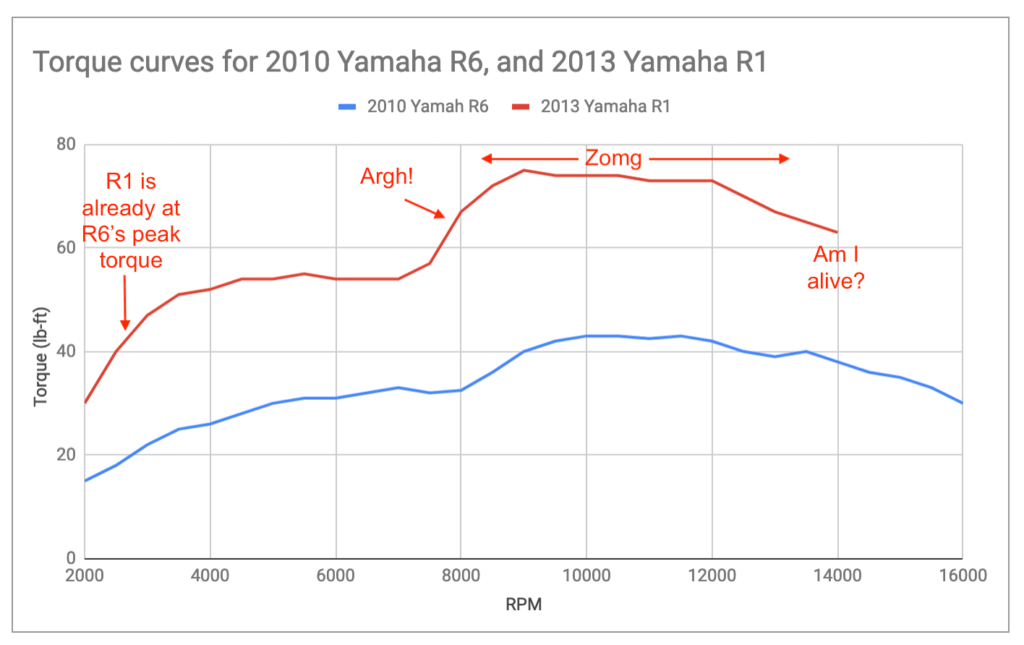
Given all that, people often choose to ride the Yamaha R1 on the street, and the Yamaha R6 on the track. Why is that? Becauseon the street, having torque down low can feel much more comfortable than power high up. You have to shift less, and can ride lower in the rev range, which means you don't have to make the engine scream for a normal ride to work or the shops. The R1 sounds better with its cross-plane engine, and has had more rider aids earlier. Finally, the R1 is still more comfortable.
Which isn't to say you can't ride the R6 on the street, or tour with it — many do, and at least you'll see the redline! (Maybe once, anyway).
The devil in me wants the R1. It's a bit like owning a Ferrari or a Lamborghini; you ride them because you want to ride a superbike.
Yamaha MT-07/XSR700 vs Yamaha YZF-R6: Almost completely different
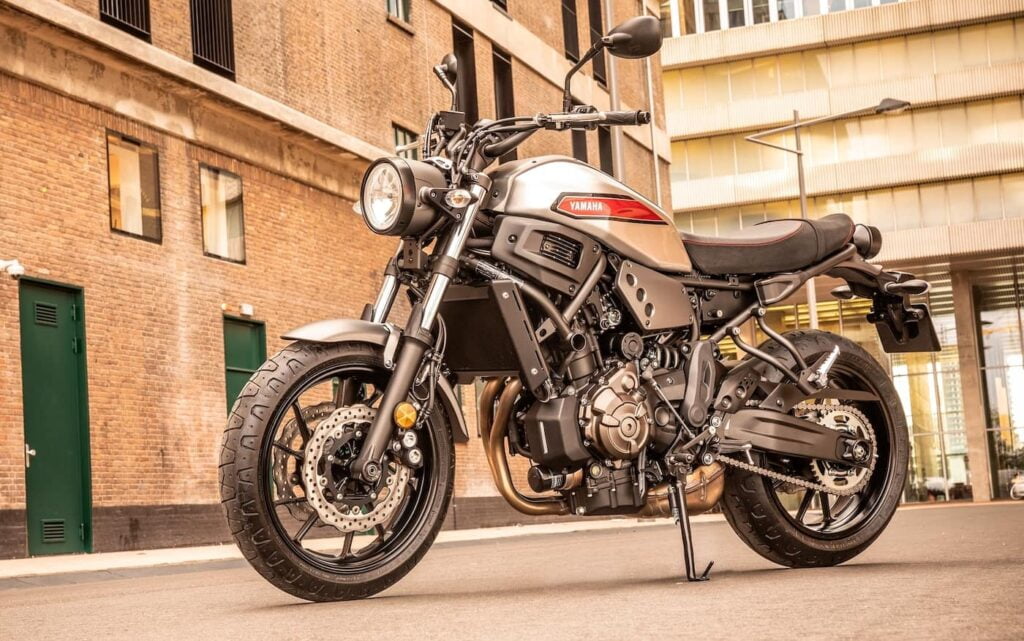
The MT-07 and XSR700 are comfortable, upright sports motorcycles. They're styled differently (the XSR is the "sport heritage" type styling), but powered by the same Yamaha 689cc parallel twin "CP2" motor, with a 270-degree crankshaft offset that gives it the same purr as a 90-degree V-twin. It's amazing sounding, especially with a great exhaust on it.
Yes, either the MT-07 or XSR700 is fast. They're sporty. You can have a lot more fun on the street with it, and still have a lot of fun at the track. You could probably keep up with — maybe even beat — a Yamaha R6 up to about 60 km/h or 40 mph, and be even at up to 100 km/h or 60 mph, assuming you can shift quickly, because of gearing and the fact that it'd be easier to put the torque down.
For most of the band between 2,000-7,000rpm, the parallel twins makemore torque than the R6.So it's only if you want to regularly rev above 8,000rpm (like, most of the time!) that you'll see a huge benefit in riding a high-revving sports motorcycle.
The MT-07 or XSR700 (same engine, remember) produces more torque, and lower down, with 50 lb-ft @ 6,500 rpm and 74 hp @ 9,000 rpm. The torque comes on a lot earlier too, making the the twin a well-known "hooligan machine", prone to making the owner do wheelies through the city.
It's also a great starter machine, particularly in restricted form. And that probably says it all: The Yamaha R6 doesn't have a restricted form, and is absolutely not a beginner's machine.
Yamaha YZF-R7 vs YZF-R6
In 2021, Yamaha released the YZF-R7 (re-releasing a bike with the same name as a bike 20 years ago), using the same parallel twin as in the MT-07.
While it has the same engine foundation as the MT-07, Yamaha changed the riding position to be much more sporty, and gave the new R7 a lot of high-end components that make it a track contender, even if without the top-end of a four-cylinder sportbike.
It's a different bike, but it's worth investigating which one best suits the tracks in your area. See here for a full discussion of how it fares next to the YZF-R6.
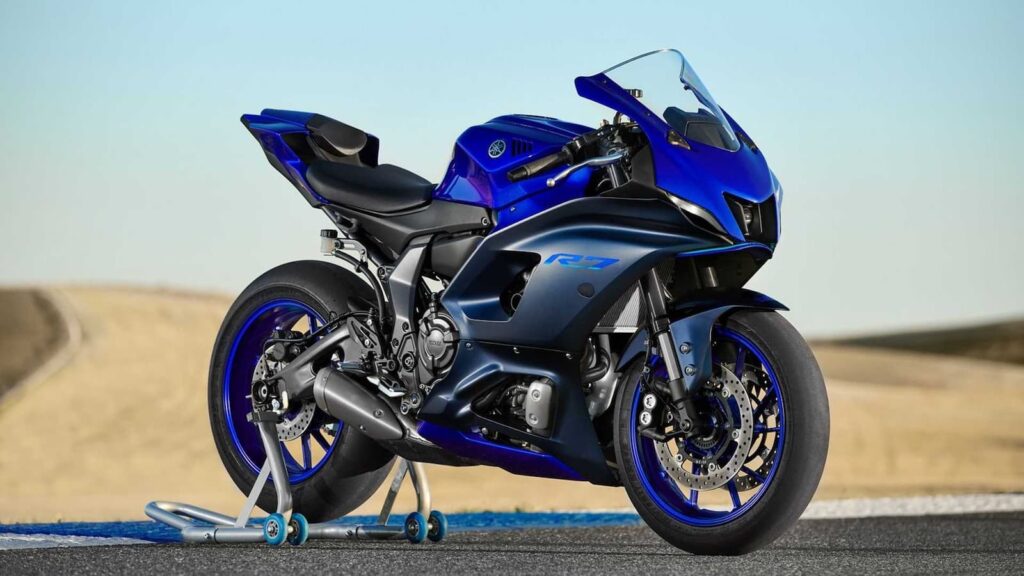
Honda CBR600RR, Suzuki GSX-R600, Kawasaki ZX-6R (636), Triumph Daytona 675
All other four-cylinder 599cc motorcycles are contenders against the Yamaha R6.
They're all great, and general advice is to sit on them all and see which one fits your ergonomics best, and which ones you like the look of. In a straight line or on the track, they're often separated by a fraction of a second. That matters to you if you're a top-seeded winner — in which case, you probably belong to a racing team, and your bike decision has been made for you!
While models have varied over the years, here's how the various Japanese four-cylinder motorcycles are compared:

- The Kawasaki ZX-6R (636): Known in many shoot-outs has been the most powerful, partly because for most of the time it has been produced, it has been available as a 636cc motorcycle. Because of this, it's also known for having better mid-range torque than the other 600s. However, you had better like the colour green! (It's available in other colours, but green is very popular.) The ZX-6R has had ABS and power modes for much longer, since 2013.
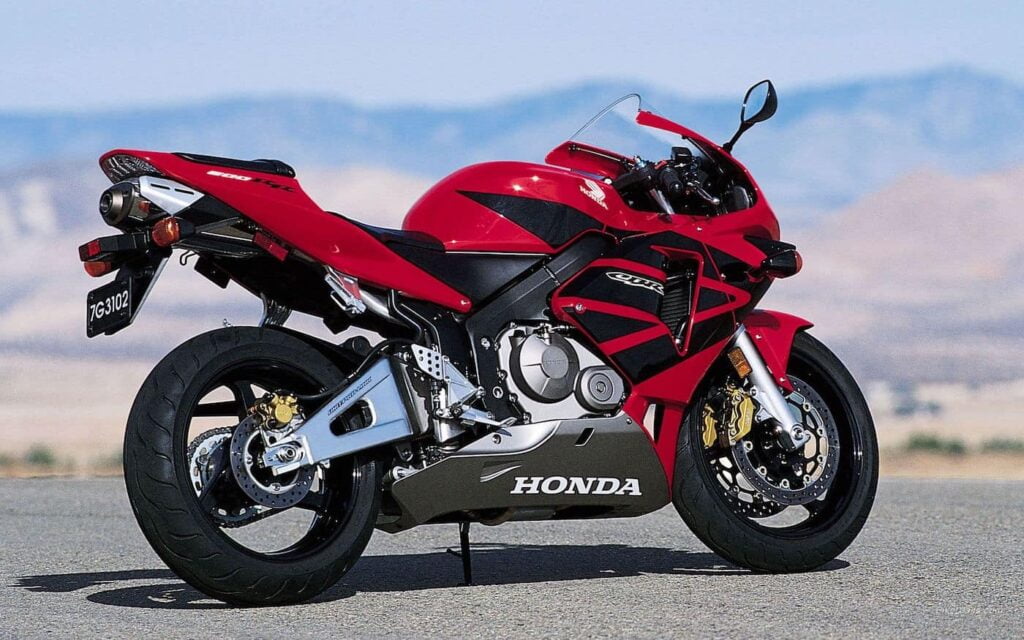
- The Honda CBR600RR: Known simply for being the most comfortable (even though the CBR600F4i was always the REALLY comfortable sports motorcycle), the CBR600RR is fast, light, and effective. This was, after all, the track-focused alternative to the F. It's still pretty compact, so if you're tall, it can feel cramped. This was the gold standard for a while, but the CBR600RR hasn't been updated since 2013 (and has been discontinued by Honda in light of waning global demand, and Euro4). So… future classic?
- The Suzuki GSX-R600: Also as effective as the CBR600RR, but mired a bit by the "Gixxer" bro-like name the community has given it. This shouldn't put you off if you find a good deal. But be extra attentive to evidence of burnouts and poor maintenance by previous "Gixxer bro" owners.
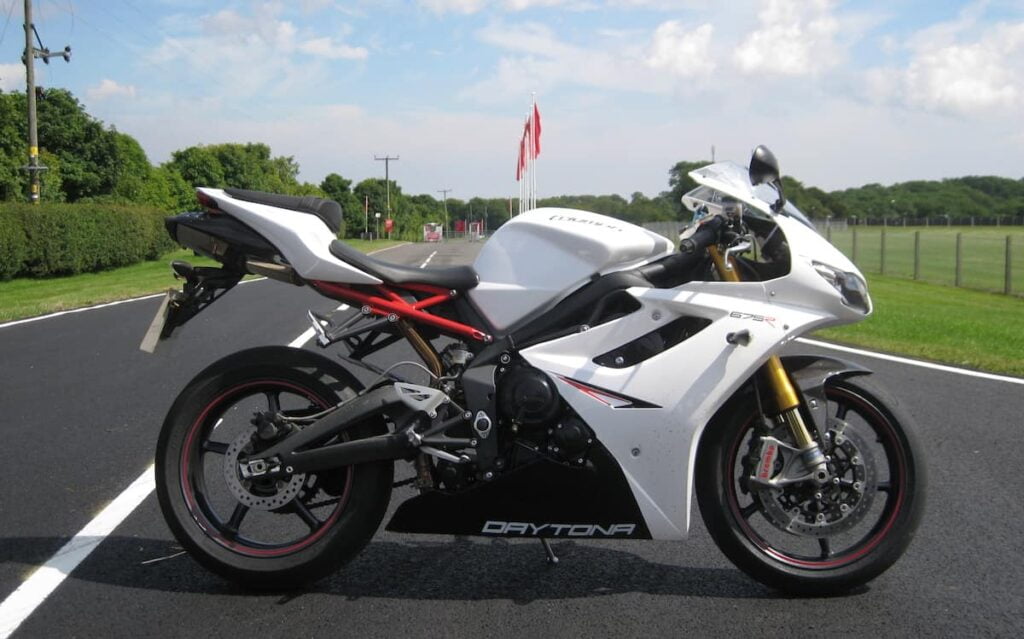
- Triumph Daytona 675R: Often the lightest in the class, and with power up there in the 120hp range. Has looks to die for, and is visually distinct from others in the class. Powered by a triple (with more displacement), the Daytona has a unique and intoxicating high-rev howl that separates it from the four-cylinder bikes in its class. Parts are slightly more expensive.
Is the Yamaha R6 uncomfortable to ride?
If you look through the model pictures below, you'll notice that early on, the Yamaha R6 was actually quite roomy. The foot-pegs were always quite high, but for a decade after it was launched, the R6's clip-ons weren't too low, or angled down too much.
Compared to the modern R6, the original was… roomy. But all of them encourage a distinct forward lean, with pressure on your wrists.
What to look for when buying a used Yamaha R6
Oddly, the Yamaha R6 isn't known for having any systemic faults! No electrical issues it was historically plagued with, no failing starter…
Just go over the used motorcycle checklist, paying particular attention to things that happen on sports motorcycles:
- Low quality"Chinese" fairings. Where are the originals?
- Exhaust add-on (especially just a slip-on exhaust)without a tune. In these cases look especially for "fake" slip-on mufflers. I like to generally buy a motorcycle with a power commander
- Evidence ofcrashing (honestly, it should be rare that an older one isn't crashed!)
In America, the R6 is the dream motorcycle for many a kid who gets it as their first motorcycle — and drops it. So make sure the one you have is fully aligned with no ongoing evidence of crash damage.
Yamaha R6 Model History
With the basics out of the way, let's look at how the Yamaha R6 evolved over time. Check the end for my thoughts for the years/models of Yamaha R6 to buy!
1999-2000 Yamaha R6 — The Original
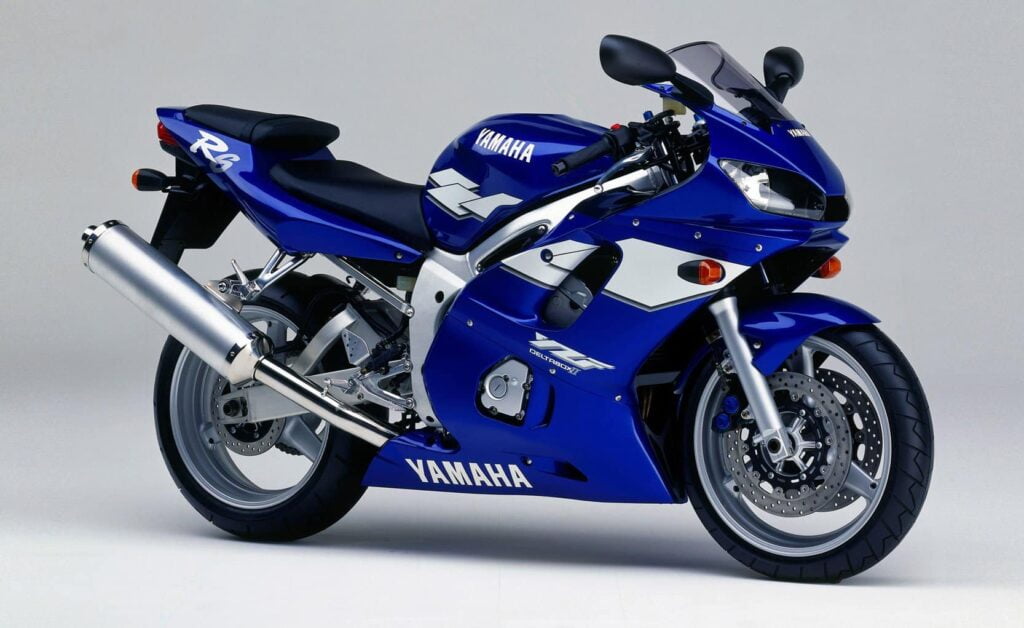
This was the original Yamaha R6! Released in 1998 as a 1999 model year.
Baseline specs of the 1999 Yamaha R6 (against which to compare):
- Power: 80 kW (108 hp) @ 12,500 rpm rear wheel, but with 120hp at the crank
- Torque: 57 Nm (42 lb-ft) @ 10,500 rpm
- Wet weight: 200kg (440 kb)
- Carburettor engine, four-cylinder 600cc, 12.4:1 compression ratio
At the time, the original Yamaha R6 made more power than any other 600cc-class supersport motorcycle. The favourite at the time, CBR600F, made 99 hp at most.
The original Yamaha R6 was also the lightest and most compact motorcycle in its class, with a dry weight of 168 kg and wheelbase of 1382mm (54.4 inches).
Everything said above about the Yamaha R6 applies to this original model. It was fast and ferocious, a quick handler, and very easy to ride fast because it was so light.
This was also a more comfortable model than more recent times. Look at the clip-on position: it's quite high!
Unfortunately it's pretty hard to find them in good condition. Even if you do find them, I usually recommend fuel-injected models, just because they're easier to maintain. (I mean, you don't maintain them. Fuel Injection just works seemingly forever, and if it fails, your carbs will have needed work ten times in the same time frame.)
2001-2002 Yamaha R6: The Refined Original
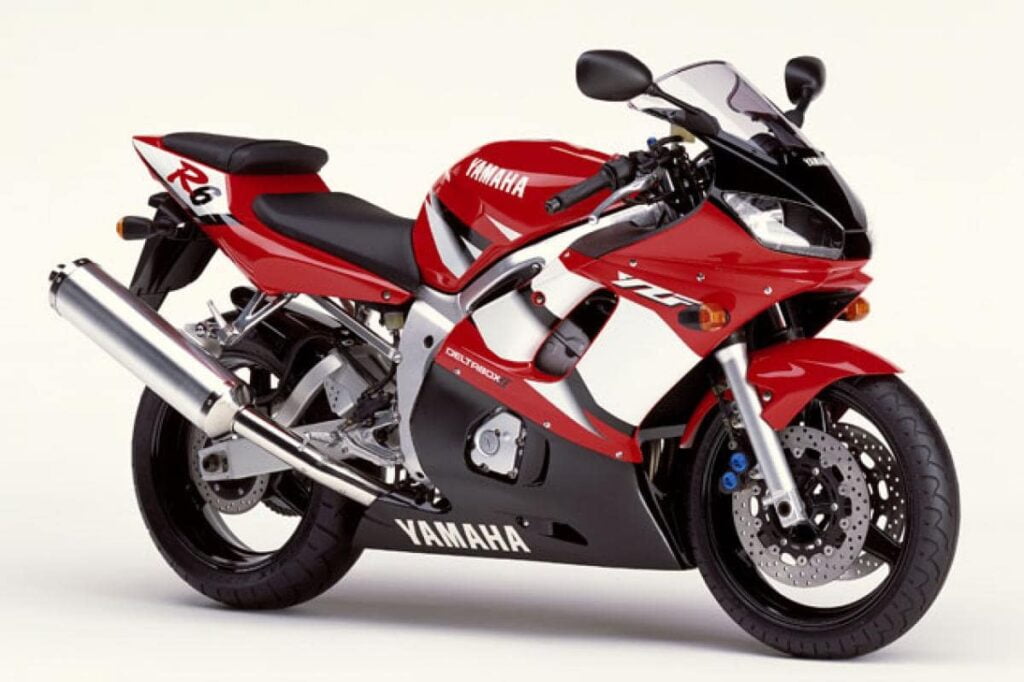
This was a small update using the same engine, but with revised power and smoother torque delivery. It also had a lower weight, although later models would get better.
Cosmetically it looked the same, though had improved lights.
In 2001 and 2002, the R6 was still the best supersport motorcycle to buy. But things would change soon!
I wouldn't recommend getting this early motorcycle, just because it has carburettors. There's nothing wrong with carburettors, but you just don't have to maintain fuel injection systems.
Specs for the 2001 Yamaha R6:
- More power: 88.2 kW (118.3 hp) @ 13,000 rpm
- More torque: 60 Nm (44 lb-ft) @ 11,000 rpm
- Multi-plate clutch
- Lower wet weight: 193kg (426 lb)
2003-2004: Fuel Injection

Changes and specs for the 2003 Yamaha R6:
- New fuel injected engine!
- Slightly less power: 86 kW @ 3,000 rpm ("We're still figuring FI out")
- About the same torque: 61 Nm (45 lb-ft) @ 11,750 rpm
- Lighter: 188 kg (415lb) — lightest the R6 ever was by a small margin of 2kg
The most important change to the 2003 Yamaha R6 wasn't actually to the Yamaha R6. It was the competition.
In the same year, Kawasaki released its refreshed, and fairly mental, ZX-6R 636. It was more powerful, lighter, and also fuel-injected. Because of its "cheater" displacement, people (like me) who have no intention of doing competitive racing love it.
In the same year, Honda decided to stop trying to please everyone with the CBR600F4i, and released the smaller, more powerful, and lighter CBR600RR. This changed everything. That was now the motorcycle to beat, and it took a while for Yamaha to re-find its footing.
Actually it took years. The CBR600RR won the world superbike championship for the next solid five years in a row.
2005: Better suspension and brakes, more power
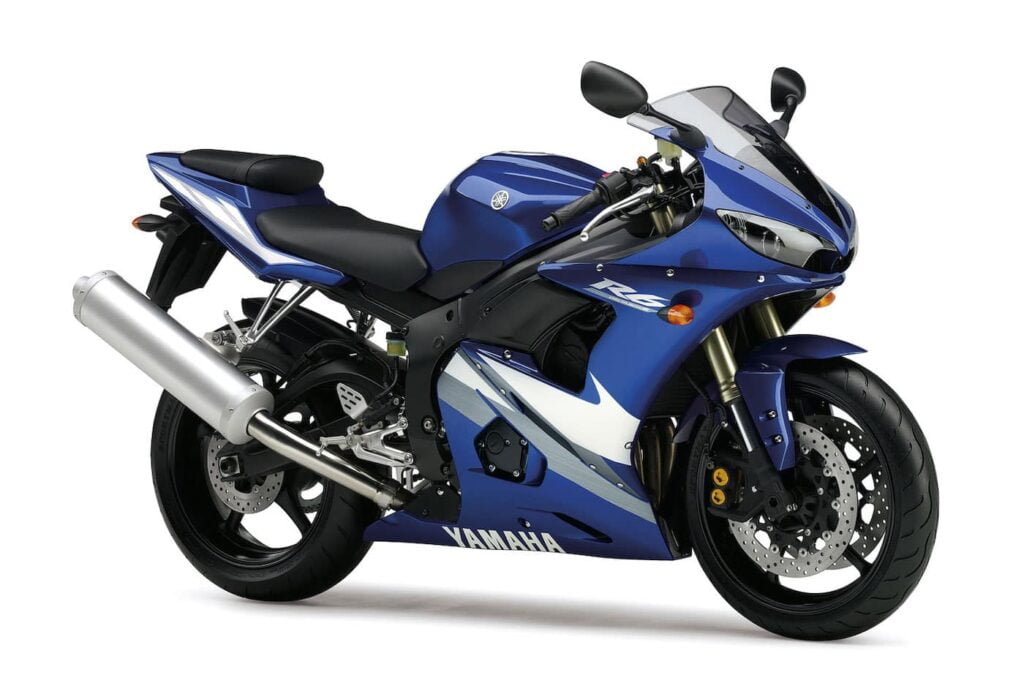
In 2005, a few changes made this the earliest model Yamaha R6 you should buy!
It looked visually the same, but there were a bunch of internal changes.
Specs for the 2005 Yamaha R6:
- Power back up to carburettor days: 88 kW (118 hp) @ 13,000 rpm
- Torque still same: 61 Nm (45 lb-ft) @ 12,000 rpm
- Slightly heavier, but still lighter than all but most recent: 192kg (424 lb)
- Upside-down forks, finally!
- Bigger brake discs (310mm)
The fact that the 2005 Yamaha R6 finally got upside-down forks brought the R6 into the modern racing age.
Yamaha also increased the size of the brake discs on the 2005 Yamaha YZF-R6, up from 298mm to 310mm.
2006-2007: Ride by wire, high/low-speed damping, slipper clutch, and a tachometer scandal
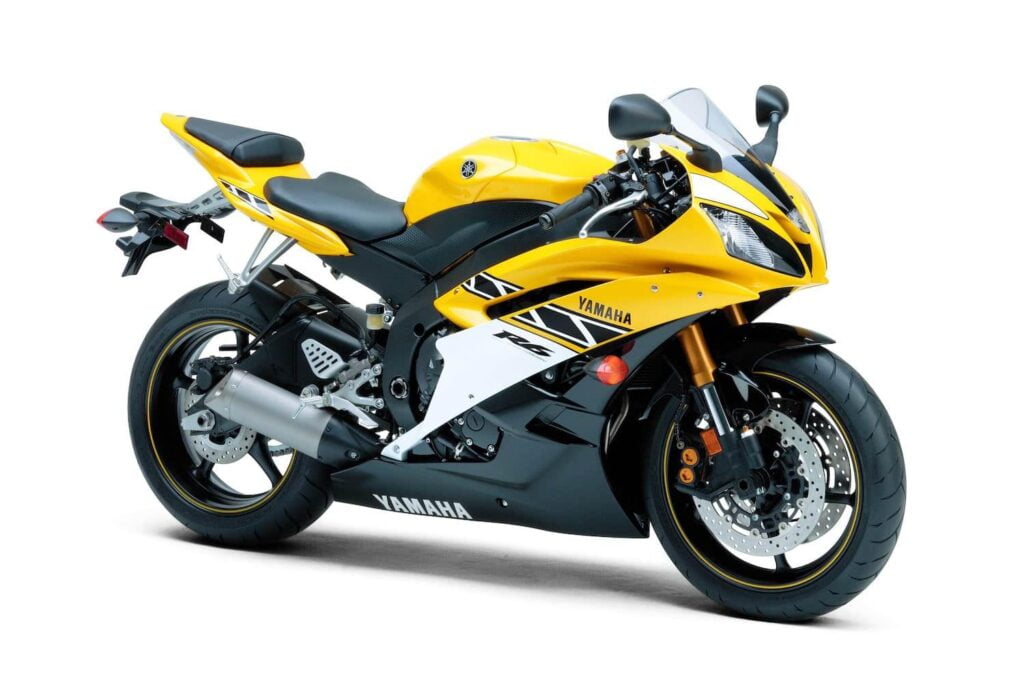
The 2006 Yamaha R6 was released in "Anniversary Edition" yellow livery, just like its brother the R1.
Specs for the 2006 Yamaha R6:
- Higher power: 93 kW (125 hp) @ 14,500 rpm (some reports are 130hp)
- Same torque: 59 Nm (44 lb-ft) @ 11,500 RPM
- Higher compression engine at 12:8.1
- Same weight (192 kg)
- High-speed and low-speed compression damping
- 45-tooth rear sprocket, down from 48, changing the final drive ratio for better low-down response.
- Slipper clutch
In 2006, Yamaha added ride-by-wire to their R6. It was thusthe first production motorcycle with this feature — before even the R1 got it!
Yamaha also added 2-way compression damping adjustability to the fork. You could separately set high-speed and low-speed compression damping — something unique in the class.
If you look closely, the riding position just got a bit more extreme. It still has room though.
The 2006 Yamaha R6 was mired with a scandal about the tachometer and redline. Yamaha claimed the R6 had a redline of 17,500 rpm in all their promotional blurbs. A massive 17,500 rpm! Higher than any consumer motorcycle at the time, and higher than most in memory (the four-cylinder 250cc bikes not having been sold for a while, and for even longer in the US). It would have been amazing if it were true.
Unfortunately, it wasn't true. While the tachometer showed a needle that went up to 17,500 rpm, the true RPM was around 16,000 (some measured it at 15,800, and some at 16,200). Yamaha said it was "tachometer error". But it was such a scandal that Yamaha actually offered to buy back any R6 if the customers were unhappy.
2008-2009: YCC-I Variable-length intake
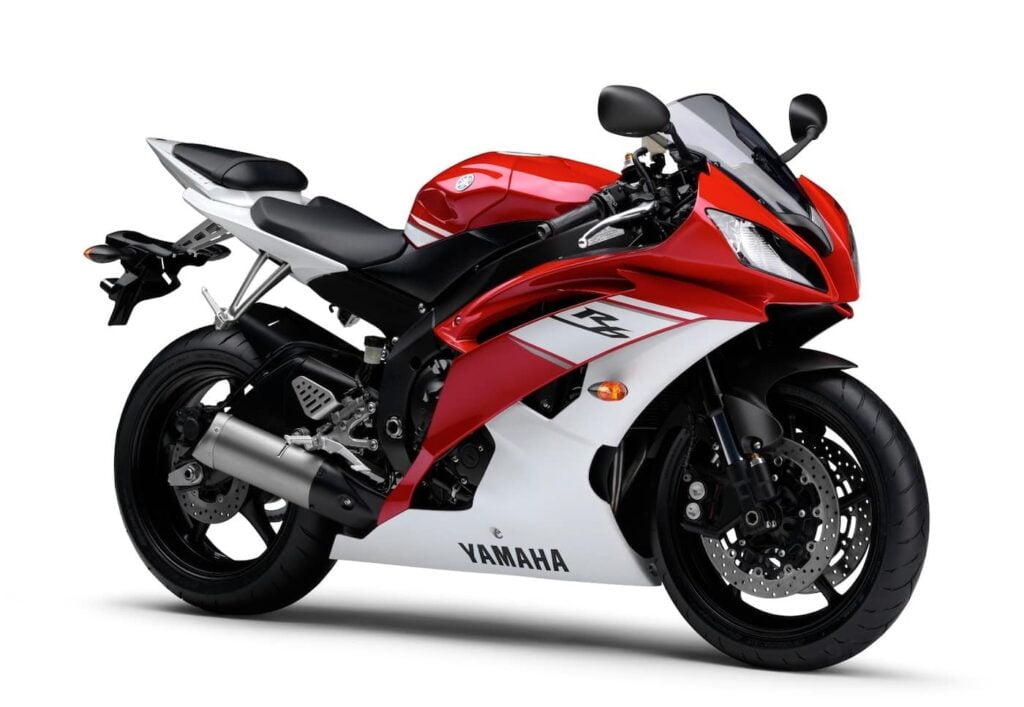
The 2008 model year had the highest power-weight ratio of any other R6, even to today. It doesn't mean they're the best, but it's some kind of bragging right!
- More power with 95kW (127 hp) @ 14,500 rpm — actually the most powerful the R6 ever was, by a few kW!
- Similar torque with 59 Nm (43 lb-ft) @ 10,500 rpm
- YCC-I Variable Length Intake – very rare on production motorcycles (brought from the 2007 Yamaha R1)
- Higher compression engine (13.1:1), continued until today (you now need high-octane fuel!)
- Wet weight of 189kg (417 lb) — nearly the lightest the R6 ever was
- Even more extreme position — bars that are lower, and further forward
The 2008 R6 looked nearly identical to the 2006-2007 model, but got a large amount of under-the-hood updates.
The most interesting one was the Yamaha electronically controlled variable length intake system. This had, at the time, only been implemented on the 2007 R1, and on top-of-the-line MV Agusta superbikes.
How Yamaha YCC-I variable-length intake works: Bikes deliver bigger, smoother power at low revs with a longer set of intake pipes, but make more power when intakes are shorter at high revs. So most motorcycles choose a compromise. Not Yamaha! Yamaha implementeda set of funnels whose length can be changed by the computer, for longer intakes at low revs but shorter length at high revs.
Note on the 2009 Yamaha R6 — Impact of EPA Tier Two
The 2009 Yamaha R6, was a re-program to meet "tier two" EPA regulations. The major changes were a) a 100mm longer muffler and b) an ECU reprogram.
Unfortunately, the 2009 Yamaha R6 wasn't really a hit. The reprogramming seemed rushed. The earlier '08 R6 had steady growth all along the RPM range, while 2010-2016 model shows heavy dips and inconsistent fueling, with a 1500-rpm flatspot. The 2009 Yamaha R6 was down six horsepower (~4 kW) on the 2008 (give or take, depending on who was measuring).
Many riders and reviewers complained about the 2009 Yamaha R6, and it lost its podium momentarily. The only way to rectify this problem is via an ECU remap (and probably a different exhaust system while you're at it).
2010-2016 Yamaha R6
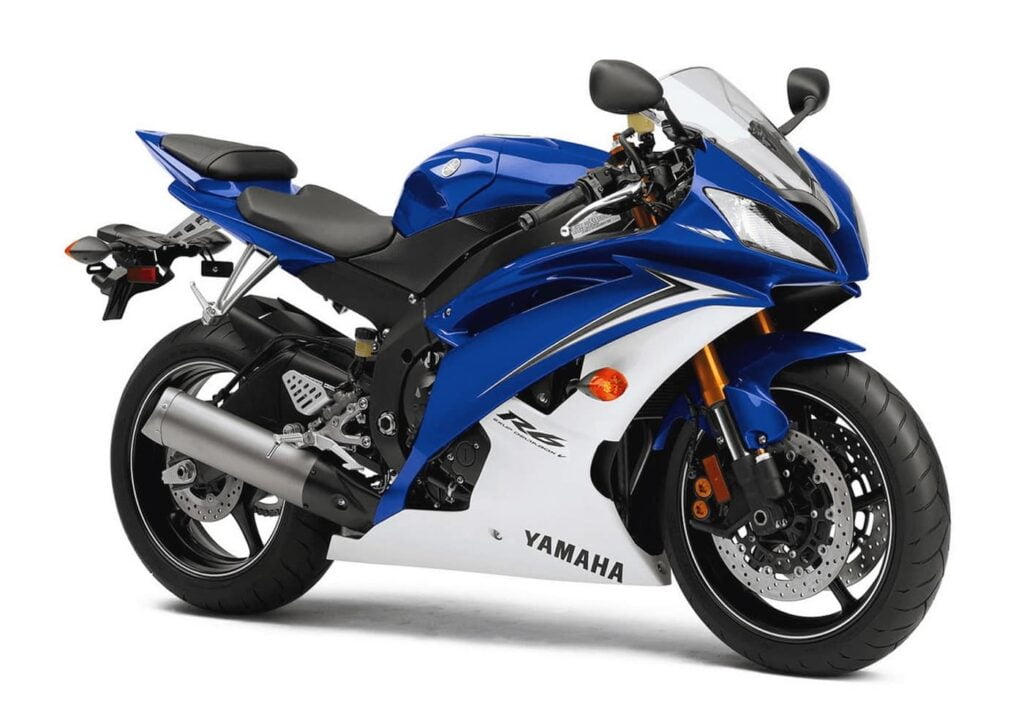
- Slightly less power at 91 kW (122 hp) @ 14,500 rpm
- Slightly less torque at 58 Nm (42 lb-ft) @ 11,500 rpm, but more torque in the midrange
- Still very light at 189kg (417 lbs) wet weight
- Somewhat ugly exhaust (it's not bad, but there are better options)
Yamaha attempted to claw back its market after fans were disappointed by the 2009 model. Yamaha did this by revising the exhaust, air filter, and mapping.
For 2010, the power dropped a tad, but there's more torque earlier in the rev range, making it feel less peaky overall.
The result is a bike that is slightly less powerful than its predecessor, and a bit slower in the sprint to 200 km/h (9.8 seconds, vs 9.7 seconds for its predecessor, per Motociclismo).
The goal of the 2010 Yamaha R6 was to improve overall ride-ability while still meeting the strict 2009 EPA guidelines, and to recover the podium. It did this to a degree — the R6 remained the class leader in the six hundreds — even though peak power was still down.
2017-2020 Yamaha YZF-R6
The 2017 R6 got updated styling, looking more like the current R1, which is itself inspired by the YZR-M1 MotoGP motorcycle. The new body work is supposed to reduce drag by 8% over previous models!
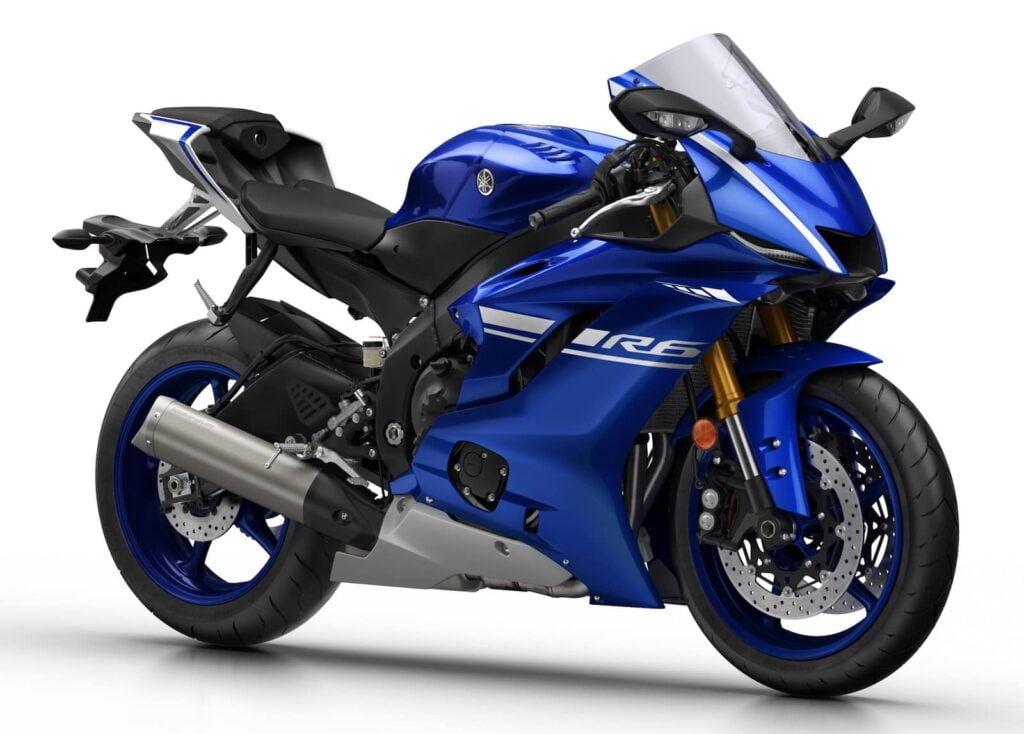
The minute I sat on the 2017 (actually a 2018) Yamaha R6, I noticed how much more relaxed the riding position was than before. Apparently, this is from the shape of the tank and the changes they made to the seat. You can't tell until you try it! It was different from other super-sports in the 600 class; I felt like I was sitting on the chassis, instead of feeling like I was sitting on top of the front end. The reshaped, larger fairing added to the feeling.
The 2017 Yamaha YZF-R6 also got standard ABS, ride modes, and traction control. Which is petty amazing since the weight barely changed!
- Less power, similar to old-school carburettor days: 87 kW (117 hp) @ 14,500 rpm
- More torque: 62 Nm (10,500 rpm)
- Similar weight: 190kg (419 lb)
A lot of people say "Traction control? Bah! You don't need it on a small bike!". To a degree, this is true. There's a lot less torque that might call wheel slip. But there still is slip when you really get on it, depending on the conditions and your lean angle.
Another update to the electronics is an OBD port, which means you can do engine diagnostics (or remapping) with an OBD adaptor and an Android phone equipped with the TuneBoy app.
Personally, I found the 2017+ R6 to be the easiest to ride. I think this is for two reasons:
- Firstly, it hastraction control. People say you don't need it on a 600cc class motorcycle, and they're right in that you don't need it like you do on the 200 hp Yamaha R1… cripes. But still, it gives you confidence. Yamaha's stated intention is to manage traction and tire wear, letting riders push the bike to its limits more easily. You can choose any of 6 levels (plus off), and guide the motorcycle. The result is you can hammer on the throttle, and the motorcycle stays on its line, making me feel like… I'm awesome.
- Secondly,better handling on the newer front end. I'm not sure why, but the latest R6 is evenmore stable than the previous ones I rode (the last being the 2010, admittedly). On paper, the latest R6 got thicker front forks, and a larger front axle. Whatever, the result is that under hard braking, the R6 feels more stable than ever.
In summary, the latest R6 adds a whole host of tech, without sacrificing power to weight ratio, and improving comfort and handling. It's nice when the latest is the best!
2020 — the end of the line
After 2020, Yamaha decided to retire the YZF-R6 from street use. and was discontinued globally. Tighter EURO5 emissions and a dwindling market for 600cc supersport bikes meant Yamaha didn't want to make the investments necessary to keep the R6 street legal. Wah!
This means that if you have a street-legal R6, you now have a collector's item. Hold on to that thing.
In 2021, Yamaha kind of replaced the Yamaha R6 with the YZF-R7, which uses the same CP2 engine as in the MT-07. It's obviously quite different. Here's my full explainer saying what makes the YZF-R7 special — and not the same at all.
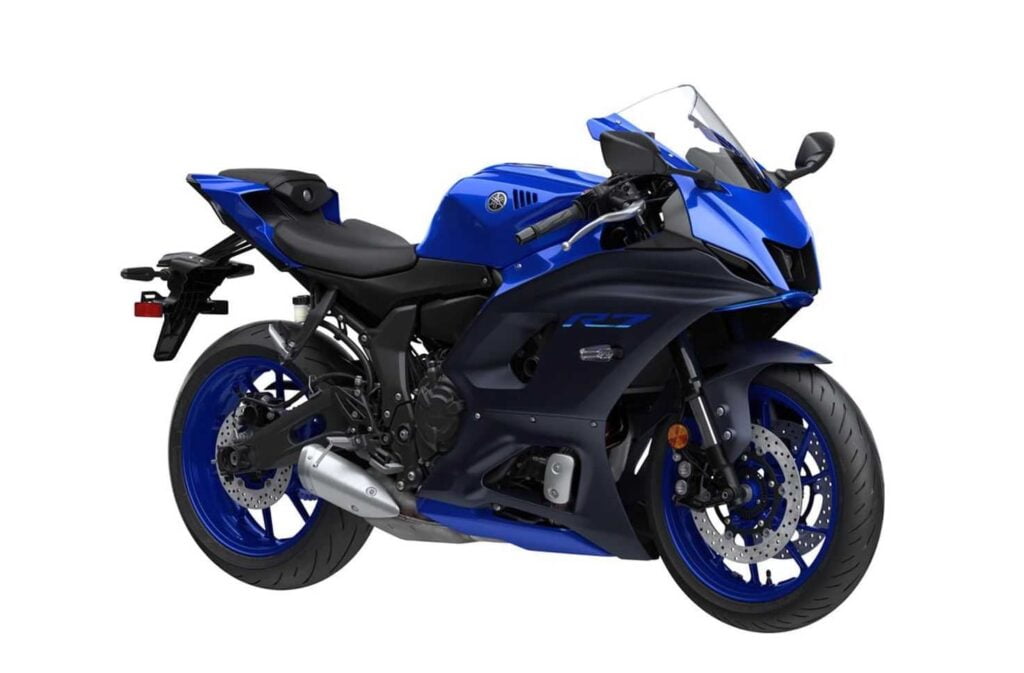
Wrap up: What's the best Yamaha R6 to buy?
If money is no object, get a 2017+ Yamaha R6. The main reason is the electronics package. It's really nice to have traction control so you can launch more quickly!
My favourite of the earlier used range: Get a 2008-09 Yamaha R6. These are the best Yamaha R6 models to buy for many reasons: They came with Yamaha's variable-length intake system, and were up on power compared to later, emissions-restricted years.
But they're all hot.
Got more questions? Get in touch.
Source: https://motofomo.com/yamaha-r6-buyers-guide/

Tidak ada komentar: